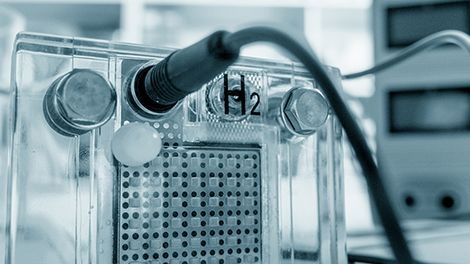What are the characteristics of hydrogen?
Hydrogen (H2) is a non-toxic gas that has neither colour nor odour. However, hydrogen is highly flammable. Therefore, it must not get into the hands of children. Appropriate containers should be stored in a well-ventilated place. It is also important to keep hydrogen away from sources of ignition and to take measures against electrostatic charging. Complications can arise if high concentrations are inhaled - but this is due to the lack of oxygen (O2). The complications range from movement disorders to unconsciousness to the danger of suffocation. Moreover, hydrogen does not pose a cancer risk and is not self-igniting. With a density of 0.0899 g/l (0°C), hydrogen is about 14 times lighter than air. Due to its high diffusion speed, it spreads quickly in all directions and mixes rapidly with air.
The density of liquid hydrogen is 70.99 g/l. Moreover, hydrogen accounts for 11.2 % of the weight of water. Its melting point is -259.125 °C and its boiling point -252.882 °C. 2.8 kilogrammes of petrol or even 2.1 kilogrammes of natural gas contain as much energy as one kilogramme of hydrogen, if you consider the lower calorific value. In other words, given its properties, hydrogen has the highest mass-related energy density among common fuels. The volume-related energy density of liquid hydrogen is only about 1/3 of that of natural gas and 1/4 of that of petrol.
Is hydrogen environmentally friendly?
In principle, hydrogen has environmentally friendly properties. If it is combusted with air in internal combustion engines, emissions occur that are very low or negligible if the combustion is managed appropriately. In hydrogen combustion, emissions of nitrogen oxides (NOx) increase exponentially with combustion temperature. With low combustion temperatures, therefore, nitrogen oxide emissions can be significantly reduced with fuels derived from natural gas or mineral oil. Pollutant emissions can be completely avoided if hydrogen is used in low-temperature fuel cells. These include, for example, polymer electrolyte membrane fuel cells (PEMFC). Power generation from hydrogen and oxygen produces only demineralized water as a reaction product.
Compared to conventional power plants, emissions are up to 100 times lower when hydrogen is used in fuel cells with a higher operating temperature. Furthermore, due to its status as a secondary energy carrier, hydrogen enables the flexible introduction of different renewable energies in the power and fuel sector. In order to assess the concrete impact of hydrogen on environmental quality, however, the entire fuel chain must be considered. This ranges from primary energy to final application.
Hydrogen: Focus on safety




With oxygen or air, hydrogen burns to form water (H2O). Hydrogen therefore involves a certain danger, but it is precisely this property that makes it a suitable fuel. In terms of its physical and chemical properties, hydrogen is no more perilous than conventional energy sources such as natural gas or petroleum. Nevertheless, high safety standards must apply when handling hydrogen, because there is a risk of explosions or hydrogen embrittlement.
In principle, with liquid hydrogen there is a risk of fire mats forming at the site of an accident. However, hydrogen rises very quickly into the air, which reduces the danger. This also applies to the mixture of hydrogen with air, which can therefore only come into contact with an ignition source for a short time at all. Due to intensive work with hydrogen, the industry has excellent and positive experience with its safety aspects. So there is a long tradition of dealing with hydrogen. Unexpected complications can occur as with any other fuel, but ultimately no greater hazards arise from the use of hydrogen than with conventional energy sources. If you are looking for more information on the safety of hydrogen, the R and S phrases as well as publications on H2 substance data (DIPPR, NIST) are recommended.
Hydrogen car safety
During regular operation of a hydrogen car, oxygen and hydrogen cannot come into contact because the hydrogen is stored separately from the oxygen in tanks. These must be much more pressure-resistant than conventional petrol tanks. For large amounts of hydrogen to be released at all in an accident, it would have to be an incident like a total loss. Even in crash tests, there was neither damage to the tanks nor any leakage of hydrogen. A higher risk of explosion exists with hydrogen if it is released in an enclosed space.
This also includes tunnels and garages, which must be protected against the dangers of hydrogen by additional ventilation and other safety measures. However, hydrogen cars are secured in such a way that explosive mixtures are prevented in the event of a fire: Before an explosive mixture can develop, the heated hydrogen is discharged and burned in the fire. Due to the existing safety measures, hydrogen cars can also be parked in garages and multi-storey car parks.
Explosion hazard with hydrogen
How explosive is hydrogen? This question is often asked because hydrogen is associated with explosions due to the oxyhydrogen experiment from chemistry lessons and some well-known accidents from the history of technology. Especially the fire on board the airship Hindenburg is still often cited as an example of the explosive danger of hydrogen. However, it has long been proven that there was no explosion at all and that the accident was not caused by hydrogen, but by an electrostatic spark. The most important thing is that hydrogen does not explode per se. Other factors are necessary for this - an oxidizer (for example pure oxygen, air or chlorine) in a certain volume ratio to the hydrogen and an ignition source such as the spark resulting from an electronic charge. Pure hydrogen cannot burn.
If approximately 4 % of hydrogen are mixed in air under atmospheric pressure, this mixture can be ignited with an ignition source. However, there is not yet a danger of explosion. This is only the case when the hydrogen concentration exceeds 18 %. As soon as about 75 % of hydrogen are present, ignition and thus an explosion is no longer possible, as the amount of oxygen is insufficient. Since hydrogen is 14 times lighter than air and thus evaporates quickly in the open air, the explosion hazard of hydrogen is further reduced. Ventilation is therefore a crucial factor, especially in enclosed spaces. When handling hydrogen, always ensure that it is kept away from ignition sources, which include electrostatic discharges (ESD).
Hydrogen is a topic with many facets - from production, transport and storage to use. With our expertise, know-how and many years of experience, we are an independent partner for safety and security by being able to test, inspect and certify various aspects of hydrogen technology.
Recognize and avoid hydrogen embrittlement
Hydrogen embrittlement is a phenomenon that has been studied for a long time and is also one of the typical hazards of hydrogen. This occurs when ionised hydrogen penetrates the crystal lattice of a metal. Accordingly, metals or even metal alloys are affected by hydrogen embrittlement. Accelerated crack growth or material failure can be caused by hydrogen embrittlement, especially at increased material stress. In this context, one also speaks of "hydrogen-induced corrosion". Whether the respective material is susceptible to hydrogen embrittlement depends on several factors:
- Shape of the crystal lattice (e.g. space or surface centring)
- Metal surface quality (e.g. welds, fractures or defects)
- Load (e.g. temperature, pressure, tension or alternating load).
Therefore, the effects of hydrogen ageing should always be taken into account when selecting components. The risk of hydrogen embrittlement can be reduced or avoided altogether by selecting the appropriate material. Stainless steel is well proven for this purpose. It is also important to know that hydrogen diffuses very quickly into other gases such as air. H+ ions can also form on catalytically active surfaces in pipes and storage tanks. This is ionised hydrogen: it is even smaller than the actual molecule, so it is able to diffuse easily into metals. In some types of steel and under special conditions, hydrogen embrittlement can occur for this special reason.
Hydrogen embrittlement in pipes of pipelines
Especially for the pipes of pipelines for hydrogen transport, the resistance or resilience against the phenomenon of hydrogen embrittlement is of fundamental importance. This is the only way to avoid hydrogen embrittlement and corrosion. The active electron of hydrogen can also endanger the joints (welds) between the pipes. The publication of official standards or regulations regarding the safe transport of hydrogen is still pending. The main challenge is that the existing natural gas pipeline infrastructure and no special hydrogen pipelines are to be used for hydrogen transport for the time being. Thus, an individual approach and one's own experience or the involvement of an experienced expert are crucial in order to specifically exclude hydrogen embrittlement and other risks.
Hydrogen hazards: Summary
How dangerous is hydrogen? This question must be considered in a differentiated way. Several aspects play a role here: On the one hand, the danger of hydrogen should be compared with that of established energy carriers. On the other hand, the effort required to control these dangers and the risk-benefit ratio must be considered. Hydrogen can be explosive when mixed with oxygen in an appropriate ratio and spreads quickly, but it also evaporates in a short time.
At the same time, the explosion hazard of hydrogen should be taken seriously and taken into account through appropriate safety precautions. A danger that should not be neglected is the colourless and odourless nature of hydrogen. For this reason, hydrogen leaks often go unnoticed. Moreover, they are even more risky in enclosed spaces. Hydrogen embrittlement, which leads to the formation of cracks, is also one of the typical dangers of hydrogen. However, these risks can be counteracted - with sufficient ventilation in enclosed spaces and the right choice of materials to prevent hydrogen embrittlement.



